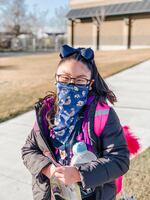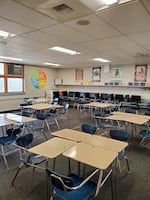Eight-year-old Gigi has a big bow in her hair and a smile on her face as she looks into a computer screen. She’s in 3rd grade at McNary Heights Elementary in Umatilla, where she’s tried to stay upbeat through a difficult year.
How has learning at home been for Gigi?
“Not good,” she said. “You always have to go on the screen, and you always have to do your attendance — and sometimes I forget to do it.”
Gigi’s mom Maria Lugo saw her daughter struggle — not so much with her work, but with losing the social experience of school.
“She misses being at school, she misses having that routine, socializing with other kids, having PE, and music,” Lugo said.
“It’s hard because she tells me she wants to go back.”
In the middle of January, Gigi was able to go back. For two hours a day, Monday through Thursday, she joined more than 580 Umatilla students who are participating in limited in-person instruction, or LIPI.

Gigi, 8, outside of school after limited in-person instruction in the Umatilla School District.
Courtesy of Maria Lugo
It’s a way for schools in distance learning to target students who need extra help, or haven’t shown up to virtual classes. But it doesn’t replace actual instruction, according to the Oregon Department of Education — it instead is meant to support what students are already learning at home.
“It is important to note that LIPI is intended to supplement not supplant instruction provided through CDL [Comprehensive Distance Learning,” according to ODE’s guidance.
At least 32,153 Oregon students are receiving limited in-person instruction as of Jan. 23, according to district-reported data compiled by ODE. That’s up from 21,445 students counted in LIPI at the beginning of December.
This new method is serving a relatively small number of Oregon’s over 582,000 students. It’s been almost a year since COVID-19 shut down schools. And as the majority of students in the state continue in distance learning, limited in-person instruction provides one of the first opportunities for students who’ve been struggling with remote learning to get back into a physical classroom with a teacher.
But that number is already changing — ODE’s latest numbers, from Jan. 30, show 27,420 students in distance learning, with more than 60,000 students in “hybrid” (part in-person, part online), and “on-site.” However, as more and more Oregon schools shift to hybrid, they’re often starting with small groups of students receiving limited in-person instruction first.
Gigi’s third grade class has fewer than six kids, and everyone wears masks. Things were different from that very first day.
“She’s a hugger,” Lugo recalled. “So she runs to her teacher, who she finally gets to see in person, and her teacher’s like, ‘no, no, no!’...It was kind of funny but I could tell it clicked right away.”
But even with all of the ways that limited in-person is different from the pre-pandemic school experience, Lugo says she’s seen a change in her daughter, after only two weeks.
“I could tell how much it helped her, even just with her mood, how she has been since going,” Lugo said.
For other students, the chance to go back to school offers something else: supervision and support, even after school.
Providing supervision and support
Hillsboro’s BLAST program is a collaboration between the city and the school district to provide an afterschool program for elementary students in the district.
Last month, the program started up again at two elementary schools, adhering to state guidance for youth programs.
So after the distance learning day is over, students in small groups at Mooberry and Eastwood elementary schools in Hillsboro can ride their bikes or walk over to the sites for five hours of supervised afterschool programming.
“We’ve targeted those students who needed to be engaged and have that adult support and might benefit from help — either with social-emotional learning or with math or literacy,” said Travis Reiman, assistant superintendent of academic services for the Hillsboro School District.
Reiman said the goal is to expand the program out to more elementary schools, to help more Hillsboro students receive support whether it’s with a snack, help on a school assignment, or just a safe place to spend the afternoon.
“We’re happy that we’re able to run those programs from one to six in the afternoon,” Reiman said. “That’s a huge chunk of time that kids might not otherwise be engaged academically or socially.”
Like Hillsboro, Oregon’s largest school district, Portland Public Schools, is starting small with its plans for limited in-person instruction. Last week, the district started with a small group of seniors at Madison High School, with plans to roll out limited in-person instruction at a handful of other elementary and high schools.
“Principals are looking at students who have not engaged,” said Portland chief of schools Shawn Bird.
“That, thankfully, is not a huge group of students. So we can really work with a smaller group to get them started and get them back on track.”
For example, high school students behind on credits, or elementary students who need help with math, reading, or social-emotional support.
Bird said limited in-person instruction is optional for students and voluntary for teachers.
PPS and Hillsboro are among a number of larger, metro-area districts not planning a broader return to in-person or hybrid instruction for a while. Both districts are targeting April to bring students back, starting with the younger grades.
And when limited in-person does happen, it can take some getting used to — and getting to know new students.
Meeting “new” students
In Nancy Swarat’s classroom, each of her five high school students sits at a set of four tables, with a lot of space between each other.
Over the two hours of LIPI, Swarat says she “darts and dashes” from student to student, offering her support, answering questions, and just helping students get work done.
“It’s a study hall with the teacher bothering you more than a normal study hall,” Swarat said.
Of her five in-person students, she only has two in her classes. She hadn’t met any of them face-to-face until limited in-person.
“That part has been interesting,” Swarat said. “It’s like, ‘hey, hi, I’m Mrs. Swarat, I’m going to help you! You don’t know me, but here we go!’”
Swarat teaches math at the high school, but with LIPI, she’s not just helping her students with math. Sometimes they need help with a biology assignment or something in language arts.
She said the time in the classroom helped students focus, and brought up grades before the end of the semester.
“Many of them were able to salvage grades that they wouldn’t normally have been able to do,” Swarat said.
Middle School math teacher Salesh Karan has nine students in his class. For the first two weeks of LIPI, he allowed time for his students to get to know each other.
“They really do not know each other,” Karan said. “We do not know these students, we’ve just seen them on video calls. A lot of times, they’re so shy… they do not turn their screens on.”
But after two weeks, Karan said his small class is talking more, and getting more comfortable in the classroom.
To make school more accessible for students, Karan moved his classroom across town. His middle school classroom is based in an elementary school.
In LIPI, he’s seeing students that weren’t showing up online catching up academically and reconnecting socially.
“With students back, we just feel that part that was missing — that connection with the students — is there,” Karan said. “We’re getting that balance.”

Desks in Nancy Swarat's classroom at Umatilla High School. Swarat has five students for limited in-person instruction. Each student sits at a table of four desks, to maintain distance.
Courtesy of Nancy Swarat
Umatilla has hundreds of students participating in LIPI, with more than 80 on a waiting list. LIPI is popular in more rural counties, with Umatilla, Klamath, Jackson, and Jefferson counties, counting higher numbers of students taking part.
But there’s still a health risk in going back to the classroom for students, for teachers, and for their families.
It’s at the forefront of local, statewide, and national conversations around school reopening. There’s research making the case for school reopenings, as pressure mounts. At the same time, there’s a concern for the consequences of reopening too quickly, or without proper communication with staff and families.
Karan, who said he has underlying health conditions, was concerned about returning to the classroom. But the safety protocols in place have eased his mind.
Swarat is a cancer survivor, which puts her at increased risk from serious health problems if she contracts the virus. She was anxious about having students back in her classroom too.
“They’ve been very good about following all the guidelines, about keeping their distance, keeping their masks on,” she said. “I only have one young man who likes to wear it under his nose — I tell him, ‘you gotta cover your nose.’”
When in-person instruction started, she asked her students to be considerate and stay at home if they’ve been exposed to COVID-19.
“It’s a matter of life and death for me,” Swarat said.
Like teachers around the state, Swarat, Karan, and their colleagues are getting vaccinated. Both Swarat and Karan received their first shot last week. But COVID-19 is not going away.
Gigi’s mom, Maria Lugo, thinks about the risk, too.
“As a parent, you’re always thinking, ‘Am I making the right decision, letting her go back? Should I just wait?’” Lugo said. “That really was hard for me.”
Gigi and her mom are happy for those two hours, in-person. This time has given Gigi some time to work on her “virtual” hugs.
“When we’re going to give a hug to someone, we have to just hug ourselves,” Gigi said.
Gigi still spends most of her school day on a screen. It’s a little less now, as school in a pandemic continues to evolve.
There’s a reason what Gigi is doing is called “limited” — that two-hour period, for a small number of students, isn’t a return to normal school.
It’s a small step in that direction.